Today, EFSP has the second post with five series of Filmshots cards, produced as a supplement for the British magazine Film Weekly. Each series presents a Hollywood film of the early 1930s, the pictures are in black and white and a few basic credits are added: the (British) film title, the two main actors and the studio. These five Filmshots series are from the collection of Ivo Blom.

British postcard by Film Weekly. Photo: Paramount. Gary Cooper and Helen Hayes in A Farewell to Arms (Frank Borzage, 1932), based on Ernest Hemingway's homonymous novel (1929).
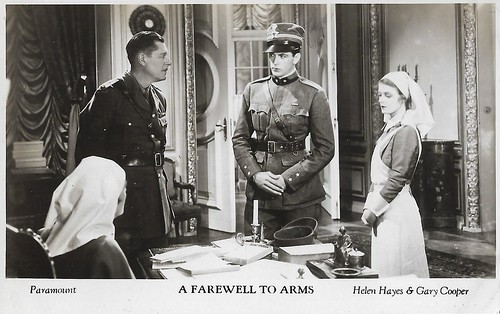
British postcard by Film Weekly. Photo: Paramount. Gary Cooper in A Farewell to Arms (Frank Borzage, 1932). The woman on the right is not Helen Hayes. The man on the left is Gilbert Emery (British major), the woman on the left is Blanche Friderici (Head nurse).
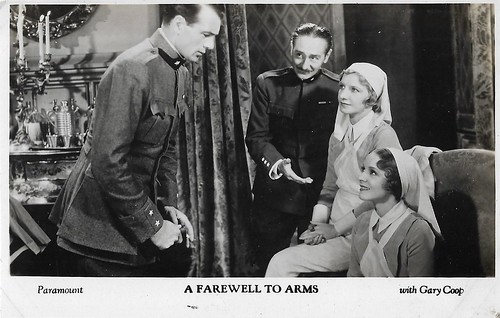
British postcard by Film Weekly. Photo: Paramount. Gary Cooper, Adolphe Menjou, Mary Philips, and Helen Hayes in A Farewell to Arms (Frank Borzage, 1932).

British postcard by Film Weekly. Photo: Paramount. Gary Cooper, Helen Hayes, and Jack La Rue in A Farewell to Arms (Frank Borzage, 1932).
A Farewell to Arms (Frank Borzage, 1932) is the first of the three screen adaptations of Ernest Hemingway's homonymous novel from 1929. Gary Cooper, and Helen Hayes star as the American ambulance driver Lt. Fredric Henry and the English nurse Catherine Barkley. The action takes place in Italy during World War I, Henry and Barkley fall in love and will stop at nothing to be together. The film also analyses Lt. Henry's feelings on war and the purpose of fighting.
Adolphe Menjou replete with Italian accent plays Cooper's friend and romantic rival, Major Rinaldi. In the supporting cast are also Mary Phillips as Helen Ferguson, a nurse and Catherine's closest friend who objects to her continued romance with the young American, Jack LaRue as the soft-spoken Italian priest, and Blanche Frederici as the stern head nurse. The film is sublimely photographed by Charles Lang who deservedly won an Oscar.
A Farewell to Arms was a highly popular war drama in its day. The film concentrates more on the relationship between the lieutenant and the nurse than on the soldiers on the battlefield. The film earned an Academy Award nomination for Best Picture of 1932-1933. Director Frank Borzage brings out the tenderness and simplicity of the young couple in love as he had done earlier in a series of classic films starring Janet Gaynor and Charles Farrell at Fox Studios.
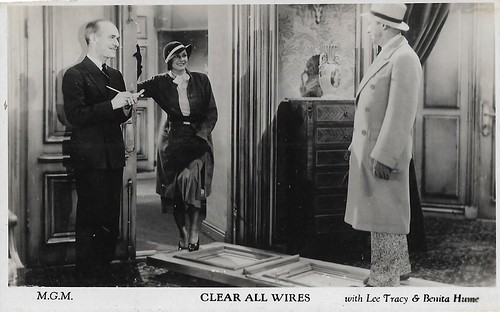
British postcard by Film Weekly. Photo: MGM. Lee Tracy and Benita Hume in Clear All Wires! (George Hill, 1933), here also with James Gleason.
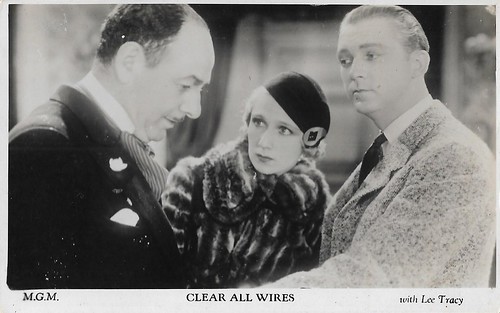
British postcard by Film Weekly. Photo: MGM. Lee Tracy in Clear All Wires! (George Hill, 1933). The woman in this card may be Una Merkel, the man on the left could be Guy Usher.

British postcard by Film Weekly. Photo: MGM. Lee Tracy in Clear All Wires! (George Hill, 1933). The man on the left here is James Gleason. The man behind the chair could C. Henry Gordon.
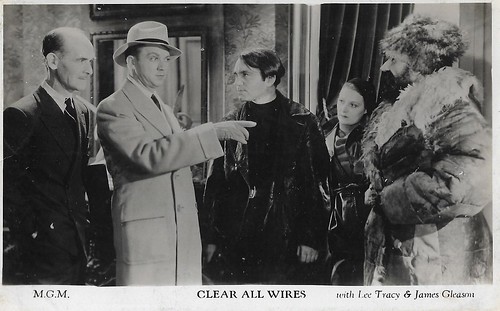
British postcard by Film Weekly. Photo: MGM. Lee Tracy in Clear All Wires! (George Hill, 1933). Left of Tracy stands James Gleason. The woman is Benita Hume.
Lee Tracy plays in Clear All Wires! (George Hill, 1933) the fast-talking Buckley Joyce Thomas, an unethical reporter who manipulates the news for his own benefit as much as he reports it. When he is in Paris to get a medal for being rescued from his alleged kidnappers, he finds that his boss, Stevens (Guy Usher), at the Chicago Globe is going with his old gal Dolly (Una Merkel). When Stevens learns that Dolly is staying with Buckley in Moscow, he fires Buckley. To get his job back, Buckley and Lefty (James Gleason) stage a great news story about the shooting of the last Romanoff, Prince Alexander, played by Eugene Sigaloff. but the plan backfires and they are now in line to be shot by the Commissar (C. Henry Gordon).
The film was based on a popular Broadway play by Bella and Samuel Spewack. In Encyclopedia of Journalists on Film, Richard Ness draws an interesting relationship with Orson Welles' later film Citizen Kane (1941), referring to the subplot of the operatic ambitions of the shrill-voiced mistress Dolly, even practicing the same Aria as in Citizen Kane. While in Welles' film the character is called Susan Alexander Kane, Lefty tells Buckley Dolly got a call from Mr. Alexander. Another scene in which Buckley meets Stalin and lights the dictator's pipe foreshadows a similar scene between Kane and Hitler in the staged newsreel in the film.

British postcard by Film Weekly. Photo: RKO Radio. Phil Harris, and Helen Mack in Melody Cruise (Mark Sandrich, 1933).
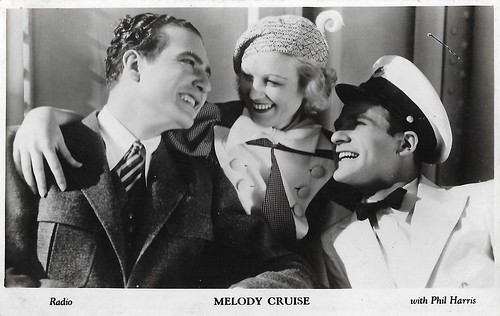
British postcard by Film Weekly. Photo: RKO Radio. Phil Harris, Chick Chandler and probably Greta Nissen in Melody Cruise (Mark Sandrich, 1933).

British postcard by Film Weekly. Photo: RKO Radio. Greta Nissen, and Charles Ruggles in Melody Cruise (Mark Sandrich, 1933).
![Phil Harris, Chick Chandler and [Greta Nissen] in Melody Cruise. RKO. Film Weekly](https://live.staticflickr.com/65535/49473027361_262d5e8942.jpg)
British postcard by Film Weekly. Photo: RKO Radio. Phil Harris, Greta Nissen, and Chick Chandler in Melody Cruise (Mark Sandrich, 1933).
Melody Cruise (Mark Sandrich, 1933) is a pre-Code romantic musical comedy about a bachelor millionaire, Alan Chandler (Phil Harris), hunted by women aboard a cruise liner. Charles Ruggles plays his best friend and womanizer Pete, Greta Nissen plays Elsa von Rader, Alan's mundane friend, Chick Chandler plays the steward Hickey whom Pete has bribed to prevent Alan from marrying, and Helen Mack is Laurie Marlowe, Alan's new friend.
After "wintering" in New York, Pasadena businessman Pete Wells prepares for his ocean voyage home by throwing a wild party in his stateroom. While drunk, Pete signs a letter written by his best friend, playboy Alan Chandler, in which his various adulterous affairs are described in detail. Determined to remain a bachelor, Alan has arranged for the letter to be sent to Pete's wife Grace but has instructed that it not be opened until he marries.
The next morning, after the letter has been mailed and the ship is in mid-ocean, Pete discovers Zoe and Vera, two of his party-goers, stranded in his stateroom. To keep the women safely in his cabin, Pete bribes steward Hickey to steal their clothes. He then hires Hickey to discourage the blossoming romance between Alan and German beauty Elsa Von Rader, fearful that it may lead to marriage and, consequently, the opening of the letter. Soon after, Pete runs into a friend of his wife, Miss Potts, a principal who is traveling with teacher Laurie Marlowe. When Pete and Miss Potts encounter the half-dressed Zoe and Vera on the ship's deck, Pete tells her that the young women are his nieces. While Miss Potts and Pete's "nieces" become acquainted, Alan accidentally waltzes into Laurie's stateroom and begins to romance her. Although attracted to the polished playboy, Laurie dismisses him, and he continues his affair with Elsa until the machinations of Hickey bring him back to Laurie.

British postcard by Film Weekly. Photo: MGM. Walter Huston, Franchot Tone, and Karen Morley in Gabriel Over the White House (Gregory La Cava, 1933).

British postcard by Film Weekly. Photo: MGM. Franchot Tone, and Karen Morley in Gabriel Over the White House (Gregory La Cava, 1933).

British postcard by Film Weekly. Photo: MGM. Walter Huston (left), Franchot Tone (centre), and Karen Morley (sitting) in Gabriel Over the White House (Gregory La Cava, 1933). The fourth card in this series still lacks.
Gabriel Over the White House (Gregory La Cava, 1933) was a controversial film on a corrupt new American president. Judd Hammond (Walter Huston) has taken his mistress Pendola (Karen Morley) to his office and neglects the worries of his people: hunger, unemployment, and gangsterism. Because of a car accident, he gets into a coma and when awakened, he has become a totally different person. He wants an agreement with protesting workers marching up to Washington and fires his corrupt cabinet. He manages to get plenipotentiary powers. He helps farmers and ends Prohibition. Together with his secretary Beekman (Franchot Tone), he makes a quick, drastic end to the racketing of Nick Diamond (C. Henry Gordon). He even manages other nations to pay back their war debts to the US, by threatening them with arms. After an international agreement is signed, he collapses and dies.
Gabriel Over the White House was made during a special moment in time. Producer Walter Wanger conceived of it as Rooseveltian vehicle, right from the start, against the wishes of Louis B. Mayer, a stark Republican, but backed by William Randolph Hearst, who not only was a big Roosevelt backer but supposedly also wrote part of the speech President Hammond gives in the film. Mayer was furious when during a preview he noticed that Hammond's presidency changes into dictatorship, but the film was released end of March 1933, about four weeks after Roosevelt had been inaugurated as president.
When the film came out, Mussolini, Stalin, and Hitler ruled their countries as dictators - Hitler only very recently. Of course, Roosevelt implemented his New Deal without dictatorship. In 1932 marches by WWI veterans and the unemployed were really taking place, while Al Capone went to prison - for tax evasion. In December 1933 Prohibition would be repealed.

British postcard by Film Weekly. Photo: MGM. Jean Harlow and Lee Tracy in Blonde Bombshell/Bombshell (Victor Fleming, 1933).

British postcard by Film Weekly. Photo: MGM. Jean Harlow and Lee Tracy in Blonde Bombshell/Bombshell (Victor Fleming, 1933).

British postcard by Film Weekly. Photo: MGM. Franchot Tone and Jean Harlow in Blonde Bombshell/Bombshell (Victor Fleming, 1933).

British postcard by Film Weekly. Photo: MGM. Jean Harlow, Louise Beavers, and Lee Tracy in Blonde Bombshell/Bombshell (Victor Fleming, 1933).
In the pre-Code screwball comedy Blonde Bombshell/ Bombshell (Victor Fleming, 1933), movie star Lola Burns (Jean Harlow) is angry with her studio publicist E.J. "Space" Hanlon (Lee Tracy), who feeds the press with endless stories about her greatness. Lola's family and staff are another cause of distress for her, as everybody is always trying to get money from the actress. All Burns really wants is to live a normal life and prove to the public that she's not a sexy vamp, but a proper lady. She tries to adopt a baby, but Hanlon, who secretly loves her, thwarts all her plans.
Burns decides she can't stand any more of such a life and flees. Far from the movie fluff, she meets wealthy and romantic Gifford Middleton (Franchot Tone), who hates the movies and therefore has never heard about Lola Burns and her bad press. They soon fall in love, and Gifford proposes marriage. Burns is to meet her fiancé's parents, but everything collapses when Hanlon, together with Burns' family, finds her and tells the Middletons the truth. Burns feels hurt by the rude way Gifford and his parents dump her and accepts Hanlon's suggestion to return to Hollywood with no regrets. She does not know that the three Middletons were all actors hired by Hanlon himself.
Sources: a.o. Wikipedia and IMDb
A Farewell to Arms (1932)

British postcard by Film Weekly. Photo: Paramount. Gary Cooper and Helen Hayes in A Farewell to Arms (Frank Borzage, 1932), based on Ernest Hemingway's homonymous novel (1929).

British postcard by Film Weekly. Photo: Paramount. Gary Cooper in A Farewell to Arms (Frank Borzage, 1932). The woman on the right is not Helen Hayes. The man on the left is Gilbert Emery (British major), the woman on the left is Blanche Friderici (Head nurse).

British postcard by Film Weekly. Photo: Paramount. Gary Cooper, Adolphe Menjou, Mary Philips, and Helen Hayes in A Farewell to Arms (Frank Borzage, 1932).

British postcard by Film Weekly. Photo: Paramount. Gary Cooper, Helen Hayes, and Jack La Rue in A Farewell to Arms (Frank Borzage, 1932).
A Farewell to Arms (Frank Borzage, 1932) is the first of the three screen adaptations of Ernest Hemingway's homonymous novel from 1929. Gary Cooper, and Helen Hayes star as the American ambulance driver Lt. Fredric Henry and the English nurse Catherine Barkley. The action takes place in Italy during World War I, Henry and Barkley fall in love and will stop at nothing to be together. The film also analyses Lt. Henry's feelings on war and the purpose of fighting.
Adolphe Menjou replete with Italian accent plays Cooper's friend and romantic rival, Major Rinaldi. In the supporting cast are also Mary Phillips as Helen Ferguson, a nurse and Catherine's closest friend who objects to her continued romance with the young American, Jack LaRue as the soft-spoken Italian priest, and Blanche Frederici as the stern head nurse. The film is sublimely photographed by Charles Lang who deservedly won an Oscar.
A Farewell to Arms was a highly popular war drama in its day. The film concentrates more on the relationship between the lieutenant and the nurse than on the soldiers on the battlefield. The film earned an Academy Award nomination for Best Picture of 1932-1933. Director Frank Borzage brings out the tenderness and simplicity of the young couple in love as he had done earlier in a series of classic films starring Janet Gaynor and Charles Farrell at Fox Studios.
Clear All Wires! (1933)

British postcard by Film Weekly. Photo: MGM. Lee Tracy and Benita Hume in Clear All Wires! (George Hill, 1933), here also with James Gleason.

British postcard by Film Weekly. Photo: MGM. Lee Tracy in Clear All Wires! (George Hill, 1933). The woman in this card may be Una Merkel, the man on the left could be Guy Usher.

British postcard by Film Weekly. Photo: MGM. Lee Tracy in Clear All Wires! (George Hill, 1933). The man on the left here is James Gleason. The man behind the chair could C. Henry Gordon.

British postcard by Film Weekly. Photo: MGM. Lee Tracy in Clear All Wires! (George Hill, 1933). Left of Tracy stands James Gleason. The woman is Benita Hume.
Lee Tracy plays in Clear All Wires! (George Hill, 1933) the fast-talking Buckley Joyce Thomas, an unethical reporter who manipulates the news for his own benefit as much as he reports it. When he is in Paris to get a medal for being rescued from his alleged kidnappers, he finds that his boss, Stevens (Guy Usher), at the Chicago Globe is going with his old gal Dolly (Una Merkel). When Stevens learns that Dolly is staying with Buckley in Moscow, he fires Buckley. To get his job back, Buckley and Lefty (James Gleason) stage a great news story about the shooting of the last Romanoff, Prince Alexander, played by Eugene Sigaloff. but the plan backfires and they are now in line to be shot by the Commissar (C. Henry Gordon).
The film was based on a popular Broadway play by Bella and Samuel Spewack. In Encyclopedia of Journalists on Film, Richard Ness draws an interesting relationship with Orson Welles' later film Citizen Kane (1941), referring to the subplot of the operatic ambitions of the shrill-voiced mistress Dolly, even practicing the same Aria as in Citizen Kane. While in Welles' film the character is called Susan Alexander Kane, Lefty tells Buckley Dolly got a call from Mr. Alexander. Another scene in which Buckley meets Stalin and lights the dictator's pipe foreshadows a similar scene between Kane and Hitler in the staged newsreel in the film.
Melody Cruise (1933)

British postcard by Film Weekly. Photo: RKO Radio. Phil Harris, and Helen Mack in Melody Cruise (Mark Sandrich, 1933).

British postcard by Film Weekly. Photo: RKO Radio. Phil Harris, Chick Chandler and probably Greta Nissen in Melody Cruise (Mark Sandrich, 1933).

British postcard by Film Weekly. Photo: RKO Radio. Greta Nissen, and Charles Ruggles in Melody Cruise (Mark Sandrich, 1933).
![Phil Harris, Chick Chandler and [Greta Nissen] in Melody Cruise. RKO. Film Weekly](https://live.staticflickr.com/65535/49473027361_262d5e8942.jpg)
British postcard by Film Weekly. Photo: RKO Radio. Phil Harris, Greta Nissen, and Chick Chandler in Melody Cruise (Mark Sandrich, 1933).
Melody Cruise (Mark Sandrich, 1933) is a pre-Code romantic musical comedy about a bachelor millionaire, Alan Chandler (Phil Harris), hunted by women aboard a cruise liner. Charles Ruggles plays his best friend and womanizer Pete, Greta Nissen plays Elsa von Rader, Alan's mundane friend, Chick Chandler plays the steward Hickey whom Pete has bribed to prevent Alan from marrying, and Helen Mack is Laurie Marlowe, Alan's new friend.
After "wintering" in New York, Pasadena businessman Pete Wells prepares for his ocean voyage home by throwing a wild party in his stateroom. While drunk, Pete signs a letter written by his best friend, playboy Alan Chandler, in which his various adulterous affairs are described in detail. Determined to remain a bachelor, Alan has arranged for the letter to be sent to Pete's wife Grace but has instructed that it not be opened until he marries.
The next morning, after the letter has been mailed and the ship is in mid-ocean, Pete discovers Zoe and Vera, two of his party-goers, stranded in his stateroom. To keep the women safely in his cabin, Pete bribes steward Hickey to steal their clothes. He then hires Hickey to discourage the blossoming romance between Alan and German beauty Elsa Von Rader, fearful that it may lead to marriage and, consequently, the opening of the letter. Soon after, Pete runs into a friend of his wife, Miss Potts, a principal who is traveling with teacher Laurie Marlowe. When Pete and Miss Potts encounter the half-dressed Zoe and Vera on the ship's deck, Pete tells her that the young women are his nieces. While Miss Potts and Pete's "nieces" become acquainted, Alan accidentally waltzes into Laurie's stateroom and begins to romance her. Although attracted to the polished playboy, Laurie dismisses him, and he continues his affair with Elsa until the machinations of Hickey bring him back to Laurie.
Gabriel Over the White House (1933)

British postcard by Film Weekly. Photo: MGM. Walter Huston, Franchot Tone, and Karen Morley in Gabriel Over the White House (Gregory La Cava, 1933).

British postcard by Film Weekly. Photo: MGM. Franchot Tone, and Karen Morley in Gabriel Over the White House (Gregory La Cava, 1933).

British postcard by Film Weekly. Photo: MGM. Walter Huston (left), Franchot Tone (centre), and Karen Morley (sitting) in Gabriel Over the White House (Gregory La Cava, 1933). The fourth card in this series still lacks.
Gabriel Over the White House (Gregory La Cava, 1933) was a controversial film on a corrupt new American president. Judd Hammond (Walter Huston) has taken his mistress Pendola (Karen Morley) to his office and neglects the worries of his people: hunger, unemployment, and gangsterism. Because of a car accident, he gets into a coma and when awakened, he has become a totally different person. He wants an agreement with protesting workers marching up to Washington and fires his corrupt cabinet. He manages to get plenipotentiary powers. He helps farmers and ends Prohibition. Together with his secretary Beekman (Franchot Tone), he makes a quick, drastic end to the racketing of Nick Diamond (C. Henry Gordon). He even manages other nations to pay back their war debts to the US, by threatening them with arms. After an international agreement is signed, he collapses and dies.
Gabriel Over the White House was made during a special moment in time. Producer Walter Wanger conceived of it as Rooseveltian vehicle, right from the start, against the wishes of Louis B. Mayer, a stark Republican, but backed by William Randolph Hearst, who not only was a big Roosevelt backer but supposedly also wrote part of the speech President Hammond gives in the film. Mayer was furious when during a preview he noticed that Hammond's presidency changes into dictatorship, but the film was released end of March 1933, about four weeks after Roosevelt had been inaugurated as president.
When the film came out, Mussolini, Stalin, and Hitler ruled their countries as dictators - Hitler only very recently. Of course, Roosevelt implemented his New Deal without dictatorship. In 1932 marches by WWI veterans and the unemployed were really taking place, while Al Capone went to prison - for tax evasion. In December 1933 Prohibition would be repealed.
Blonde Bombshell (1933)

British postcard by Film Weekly. Photo: MGM. Jean Harlow and Lee Tracy in Blonde Bombshell/Bombshell (Victor Fleming, 1933).

British postcard by Film Weekly. Photo: MGM. Jean Harlow and Lee Tracy in Blonde Bombshell/Bombshell (Victor Fleming, 1933).

British postcard by Film Weekly. Photo: MGM. Franchot Tone and Jean Harlow in Blonde Bombshell/Bombshell (Victor Fleming, 1933).

British postcard by Film Weekly. Photo: MGM. Jean Harlow, Louise Beavers, and Lee Tracy in Blonde Bombshell/Bombshell (Victor Fleming, 1933).
In the pre-Code screwball comedy Blonde Bombshell/ Bombshell (Victor Fleming, 1933), movie star Lola Burns (Jean Harlow) is angry with her studio publicist E.J. "Space" Hanlon (Lee Tracy), who feeds the press with endless stories about her greatness. Lola's family and staff are another cause of distress for her, as everybody is always trying to get money from the actress. All Burns really wants is to live a normal life and prove to the public that she's not a sexy vamp, but a proper lady. She tries to adopt a baby, but Hanlon, who secretly loves her, thwarts all her plans.
Burns decides she can't stand any more of such a life and flees. Far from the movie fluff, she meets wealthy and romantic Gifford Middleton (Franchot Tone), who hates the movies and therefore has never heard about Lola Burns and her bad press. They soon fall in love, and Gifford proposes marriage. Burns is to meet her fiancé's parents, but everything collapses when Hanlon, together with Burns' family, finds her and tells the Middletons the truth. Burns feels hurt by the rude way Gifford and his parents dump her and accepts Hanlon's suggestion to return to Hollywood with no regrets. She does not know that the three Middletons were all actors hired by Hanlon himself.
Sources: a.o. Wikipedia and IMDb
No comments:
Post a Comment